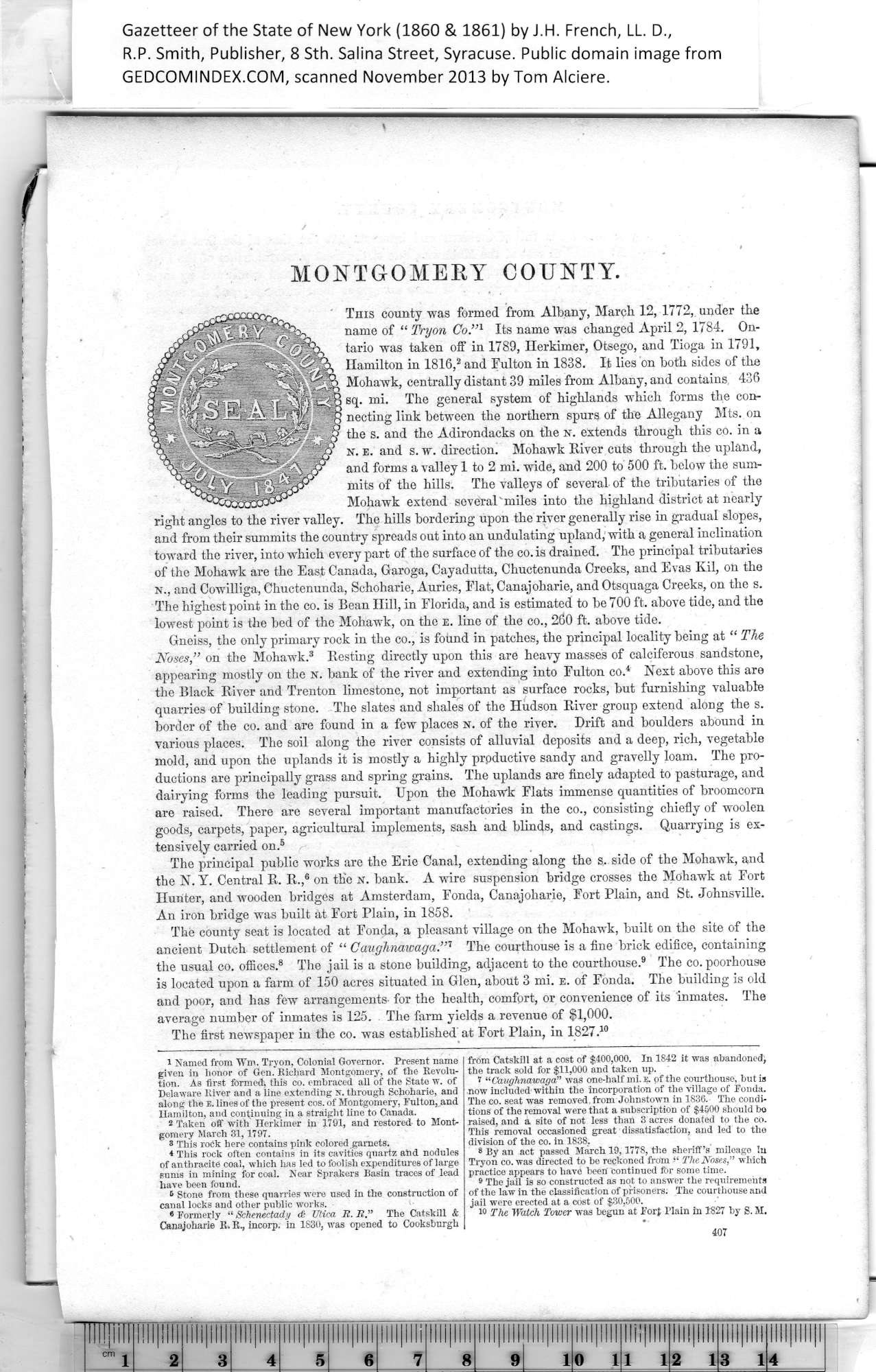|
MONTGOMERY COUNTY.
This county was formed from Albany, March 12, 1772, under the
name of “ Tryon Co.”1 Its name was changed April 2, 1784. On¬
tario was taken off in 1789, Herkimer, Otsego, and Tioga in 1791,
Hamilton in 1816,2 and Fulton in 1838. It lies on both sides of tlie
Mohawk, centrally distant 39 miles from Albany, and contains 436
sq. mi. The general system of highlands which forms the con¬
necting link between the northern spurs of the Allegany Mts. on
the s. and the Adirondacks on the n. extends through this co. in a
N. e. and s. w. direction. Mohawk River cuts through the upland,
and forms a valley 1 to 2 mi. wide, and 200 to 500 ft. below the sum¬
mits of the hills. The valleys of several of the tributaries of the
Mohawk extend several'miles into the highland district at nearly
right angles to the river valley. The hills bordering upon the river generally rise in gradual slopes,
and from their summits the country spreads out into an undulating upland, with a general inclination
toward the river, into which every part of the surface of the co. is drained. The principal tributaries
of the Mohawk are the East Canada, Garoga, Cayadutta, Chuctenunda Creeks, and Evas Kil, on the
N., and Cowilliga, Chuctenunda, Schoharie, Aui’ies, Flat, Canajoharie, and Otsquaga Creeks, on the s.
The highest point in the co. is Bean Hill, in Florida, and is estimated to be 700 ft. above tide, and the
lowest point is the bed of the Mohawk, on the e. line of the co., 260 ft. above tide.
Gneiss, the only primary rock in the co., is found in patches, the principal locality being at “ The
Noses,” on the Mohawk.3 Resting directly upon this are heavy masses of calciferous sandstone,
appearing mostly on the n. bank of the river and extending into Fulton co.4 Next above this are
the Black River and Trenton limestone, not important as surface rocks, but furnishing valuable
quarries of building stone. The slates and shales of the Hudson River group extend along the s.
border of the co. and are found in a few places n. of the river. Drift and boulders abound in
various places. The soil along the river consists of alluvial deposits and a deep, rich, vegetable
mold, and upon the uplands it is mostly a highly productive sandy and gravelly loam. The pro¬
ductions are principally grass and spring grains. The uplands are finely adapted to pasturage, and
dairying forms the leading pursuit. Upon the Mohawk Flats immense quantities of broomcorn
are raised. There are several important manufactories in the co., consisting chiefly of woolen
goods, carpets, paper, agricultural implements, sash and blinds, and castings. Quarrying is ex¬
tensively carried on.5
The principal public works are the Erie Canal, extending along the s. side of the Mohawk, and
the N. Y. Central R. R.,6 on the x. bank. A wire suspension bridge crosses the Mohawk at Fort
Hunter, and wooden bridges at Amsterdam, Fonda, Canajoharie, Fort Plain, and St. Johnsville.
An iron bridge -was built at Fort Plain, in 1858.
The county seat is located at Fonda, a pleasant village on the Mohawk, built on the site of the
ancient Dutch settlement of “ Caughnmmga.”’1 The courthouse is a fine brick edifice, containing
the usual co. offices.6 The jail is a stone building, adjacent to the courthouse.7 The co. poorhouse
is located upon a farm of 150 acres situated in Glen, about 3 mi. e. of Fonda. The building is old
and poor, and has few arrangements- for the health, comfort, or convenience of its inmates. The
average number of inmates is 125. The farm yields a revenue of $1,000.
The first newspaper in the co. was established' at Fort Plain, in 1827.10
|
from Catskill at a cost of $400,000. In 1842 it was abandoned^
the track sold for $11,000 and taken up.
I “Canghnawaga” was one-half mi. e. of the courthouse, but is
■now included within the incorporation of the village of Fonda.
The co. seat was removed from Johnstown in 1836. The condi¬
tions of the removal were that a subscription of $4500 should bo
raised, and a site of not less than 3 acres donated to the co.
This removal occasioned great dissatisfaction, and led to tho
division of the co. in 1838,
8 By an act passed March 19,1778, the sheriff’s mileage in
Ti-yon co. was directed to be reckoned from “ The Noses,” which
practice appears to have been continued for some time.
9 The jail is so constructed as not to answer the requirements
of the law in the classification of prisoners. The courthouse and
jail were erected at a cost of $30,500.
10 The Watch Tower was begun at Fort Plain in 1827 by S. M. |
1
Named from Wm. Tryon, Colonial Governor. Present name
given in honor of Gen. Richard Montgomery, of the Revolu¬
tion. As first formed, this co. embraced all of the State w. of
Delaware River and a line extending N. through Schoharie, and
along the e. lines of the present cos. of Montgomery. Fulton, and
Hamilton, and continuing in a straight line to Canada.
2
Taken off with Hei-kimer in 1791, and restored to Mont¬
gomery March 31, 1797.
3
This rock here contains pink colored garnets.
4
* This rock often contains in its cavities quartz and nodules
5
of anthracite coal, which has led to foolish expenditures of large
sums in mining for coal. Near Sprakers Basin traces of lead
have been found.
6
• Formerly “ Schenectady & Utica R. R” The Catskill &
7
Canajoharie R. R., incorp. in 1830, was opened to Cooksburgh
|
